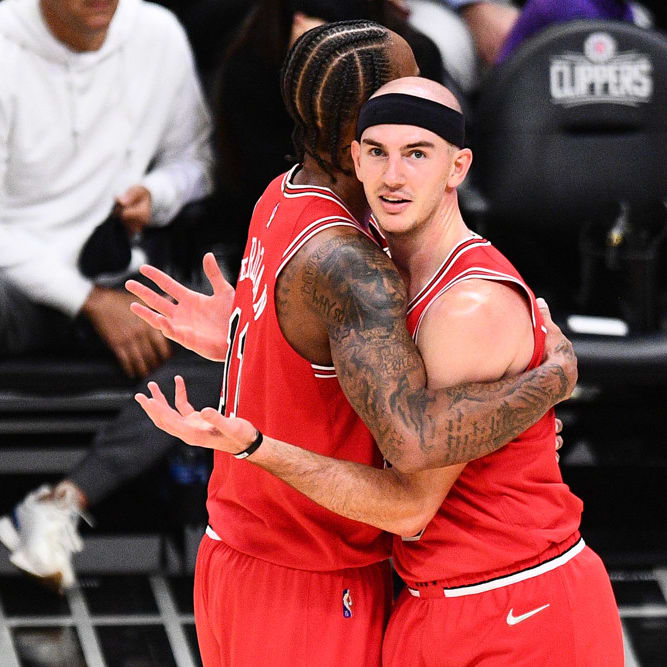This article is part of our Advanced Stats Analysis series.
Performance Meters (MM and RPM)
Ride the Tide
As I neared the end of the regular season of the RotoWire Yahoo! Staff League, my team surged forward, riding the red-hot Kevin Durant. I was the first seed throughout the entire course of the regular season. There was no doubt in my mind that I would take home the gold.
Turn the page to the playoffs, and now I find myself facing off against RotoWire NBA editor Kyle McKeown's team in the finals, not too sure if I will come out victorious. Sure, Durant's hot streak took on a heavy load for me during the previous two weeks, but even superstars have to come back down to Earth at some point. His averages of 29.0 points, 6.0 rebounds, 6.0 assists, 0.8 steals, 0.8 blocks, and 2.5 three-pointers made over the last four games are hardly anything to complain about. But somebody else on my team had to make up for Durant's lost fire. I needed Brandon Jennings and Nikola Vucevic to create some magic. As luck would have it, things didn't turn out so well. However, a lesson can still be learned through this experience.
In previous articles, I introduced my Sustainable Dynamics Ratings (SDR) and Percentage Magnitude Index (PMI). While SDR and PMI measure a player's impact on a team for the season, other methods are used to measure a player's current impact and value. As a bonus to go along with the new daily fantasy basketball features RotoWire has provided this season, I want to introduce two new statistical tools I developed that will help gauge player value for the coming seasons.
Introducing the Momentum Meter (MM)
For Season-Long Leagues and Daily Contests
The Momentum Meter (MM) is a statistical tool that measures a player's momentum of production in various volume categories (points, rebounds, assists, steals, and blocks).
In other words, the MM can be used as a streak detector. It takes into account a player's most recent stretch of games, as well as season averages. Some stats are excluded from the MM. It does not independently take into account three-pointers made, field goal percentage, or free throw percentage, but that is because those categories are already reflected in the points category.
A positive MM implies that a player is either on a relative hot streak or is seeing increased production. A negative MM implies a player is on a relative cold streak or is seeing decreased production.
Initially, every players' MM is 0.00. After their first game of the season, a MM of 0.00 in most cases would imply a DNP. However, there are exceptions. A MM with an absolute value less than 1.00 implies a streak or production pattern of no particular significance. A MM with an absolute value greater than or equal to 1.00 implies a streak or production pattern of significance, whether hot, cold, increasing, or decreasing. A MM cannot be compared inter-player or intra-player. This is because MM takes into account a player's recent production and averages, statistics that vary player-to-player and change game-by-game. Refer to the chart below as a reference tool.
| Momentum Meter (MM) | Description |
| Greater than or equal to 3.00 | Extremely hot streak or significantly increasing production |
| Between 2.00 and 2.99 | Hot streak or evidently increasing production |
| Between 1.00 and 1.99 | Mini hot streak or increasing production |
| Between 0.01 and 0.99 | No significant streak or production pattern |
| Exactly 0.00 | DNP (most cases) |
| Between -0.01 and -0.99 | No significant streak or production pattern |
| Between -1.00 and -1.99 | Mini cold streak or decreasing production |
| Between -2.00 and -2.99 | Cold streak or evidently decreasing production |
| Less than or equal to -3.00 | Extremely cold streak or significantly decreasing production |
Momentum Meter (MM) Examples
Here I will use three players as examples to demonstrate the impact of the MM. All statistics are based on games played in the 2013-14 season, up until April 4, 2014.
Kevin Durant Momentum Meter (MM)
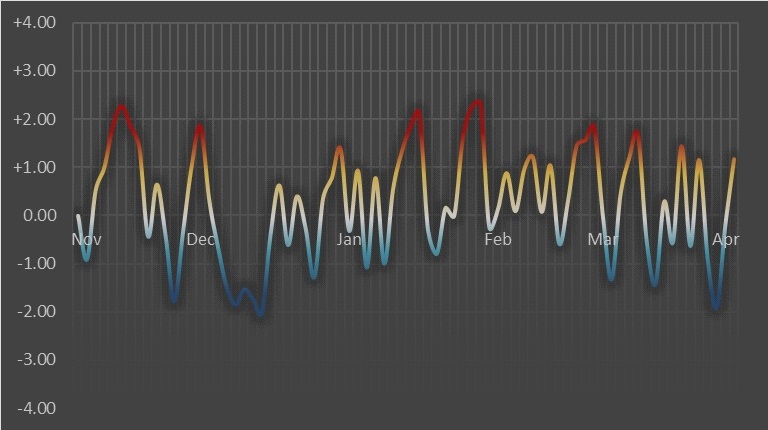
Durant's dominant performance over the past few months is no secret to anyone, as the superstar has lead the Thunder to the second best record in the NBA. His first extended hot streak began in mid-December, right after Russell Westbrook went down with a knee injury. Durant remained hot through the entire month of January (with an average MM of +1.00 over an extended period, peaking above +2.00 twice), cooled off a little in February, and then heated up again heading into March, just in time to carry fantasy teams into and through the early part of the playoffs.
Now, over the past week, Durant has been just "average," as can be seen in the graph with his MM barely ever exceeding +1.00. (Here, I will reiterate that MM does not measure how effective a player is compared to other players. Rather, it measures how a player is performing compared to his relatively recent string of games.)
Brandon Jennings Momentum Meter (MM)

As can be seen, my high hopes of Jennings catching fire in a timely manner were crushed before my eyes. Jennings had been sailing with a MM in the range of -1.00 to -2.00 for the month of March, with very little instances of a hot streak. Despite his fantastic play early in the season, Jennings hasn't been as effective since the All-Star break, and a lot of that could be attributed to the firing of Pistons coach Maurice Cheeks. It's important to understand that several factors can affect fantasy production throughout the season, and clearly, the change in coaching personnel is a prime example of a catalyst for what can affect a player's production.
J.R. Smith Momentum Meter (MM)

As can be seen in the graph, Smith's MM has hit the +/-2.00 mark multiple times, and he's even hit +3.00 at one point in the season. His dynamic streaky nature is evident in his play, as he can catch fire or have cold stretches for extended periods several times throughout a season. Fortunately for Smith's owners, he's quickly catching fire again and is undoubtedly contributing to teams still contending in the fantasy playoffs. Observe that a large portion of Smith's MM data points have an absolute value greater than 1.00, which shows that he is an extremely streaky player (compared to Durant and even the erratic Jennings). Also note that during Smith's DNPs at the beginning of the season, his MM was at 0.00, rather than at a negative value.
In addition to MM, I would like to introduce another method of measuring a player's current value and impact.
Introducing the Relative Performance Meter (RPM)
For Season-Long Leagues Only
The Relative Performance Meter (RPM) is a statistical tool that measures a player's recent performance of production in various volume categories (points, rebounds, assists, steals, and blocks) relative to season averages. In other words, an RPM can be used as a value meter for a player's current stock (in stock-market terms). An RPM takes into account a player's relatively recent stretch of games, as well as season averages. RPM does not independently take into account three-pointers made, field goal percentage, and free throw percentage. That is because those categories are already reflected in the points category.
A positive RPM implies a player is either overachieving, or is playing at a level higher than he is generally known to. In a potential trade, a player with a positive RPM could be considered a sell-high candidate. A negative RPM would imply a player is either underachieving, or is playing at a level lower than he is generally known to. In a potential trade, a player with a negative RPM could be considered a buy-low candidate.
Initially, all players' RPM is 0.00. After their first game of the season, an RPM of 0.00 would imply market-level performance. Multiple consecutive DNP's (whether due to injury or coach's decision) would result in a decreasing RPM.
An RPM with an absolute value less than 1.00 is too insignificant to imply an evident performance pattern or impose a positive or negative perceived market value.
An RPM with an absolute value greater than or equal to 1.00 would imply an evident performance pattern and could impose a positive or negative perceived market value. RPMs cannot be compared inter-player or intra-player. This is because the RPM takes into account a player's recent production and averages, statistics that vary player-by-player and change game-by-game. Refer to the chart below as a reference tool.
| Relative Performance Meter (RPM) | Description |
| Greater than or equal to 3.00 | Extremely high market value; owners may not sell |
| Between 2.00 and 2.99 | High market value; easy to sell-high |
| Between 1.00 and 1.99 | Increased market value; possible to sell-high |
| Between 0.01 and 0.99 | Perceived market value too insignificant |
| Exactly 0.00 | At market value |
| Between -0.01 and -0.99 | Perceived market value too insignificant |
| Between -1.00 and -1.99 | Decreased market value; possible to buy-low |
| Between -2.00 and -2.99 | Low market value; easy to buy-low |
| Less than or equal to -3.00 | Extremely low market value; owners may waive |
Relative Performance Meter (RPM) Examples
Here, I will use three players as examples to demonstrate the value of looking at RPM. All statistics are based on games played in the 2013-14 season, up until April 4, 2014.
Bradley Beal Relative Production Meter (RPM)
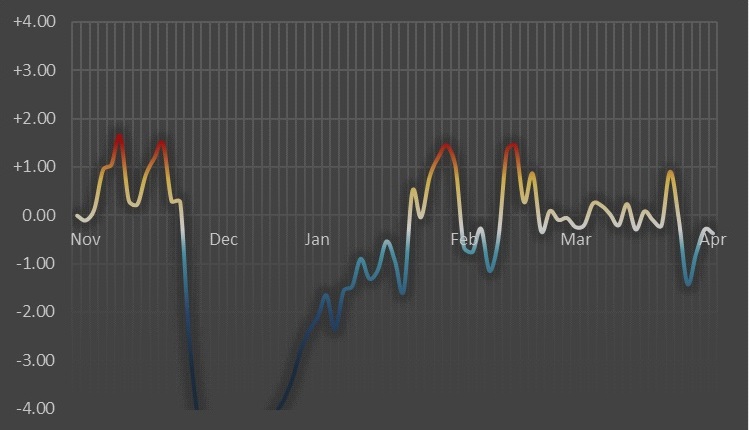
As can be seen, Beal had an incredible run to start the season, where his RPM danced above +1.00 for some time. Due to the leg injury he suffered late in November, which forced him to miss multiple games, Beal's market value quickly fell to beneath -3.00, where many owners were unpleasantly holding onto him, and some even waived him. Different from the Momentum Meter, multiple DNPs cause an RPM to sink rapidly, as an RPM represents how fantasy managers may perceive a player's value at the current time. Because of the constant decline due to Beal's extended absence, his RPM even descended to a rock-bottom figure of -7.75 (which I cut off the chart, resembling the few who cut ties with Beal). Generally speaking, a player with an RPM that low would be dropped instantly. However, in some cases, owners refuse to drop elite players even during extended injuries, because their "base value" to begin with is prime. Some examples of such players this season are Anthony Davis, Russell Westbrook, and Chris Paul. Lucky for me, I didn't have to deal with Beal's issue, as I managed to sell him high via trade in mid-November, back when his RPM was at +1.50 and before he came down with the injury. Coincidentally, there was another player whose RPM was at its lowest point at that very moment.
Greg Monroe Relative Performance Meter (RPM)
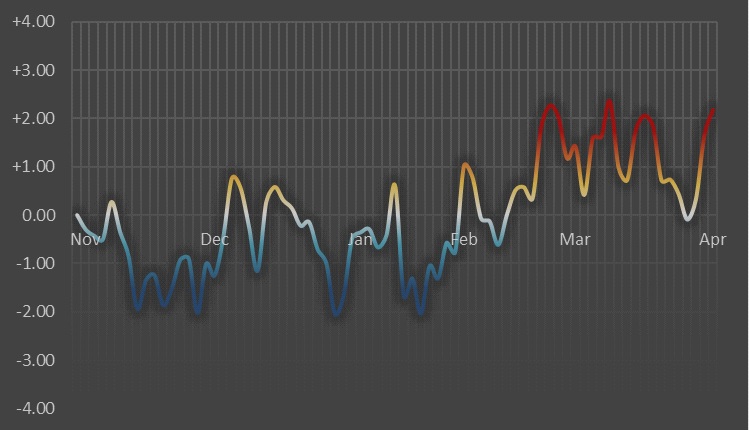
Monroe had an extremely disappointing start to the season, and his RPM remained in negative figures for almost the entire first half of the year. As you probably figured based on the context, I managed to trade Beal for Monroe mid-November, and I certainly don't have any regrets. Although it took Monroe until February before he finally began dominating in fantasy, my patience was well rewarded, as I'm riding him in the finals of my fantasy league with my high school buddies, and he's certainly outperforming Beal. (Unfortunately, Kyle has Monroe in the RotoWire Yahoo! Staff League, so Monroe is pounding me in my other league. But I'll humor Kyle a bit, since he's editing this article, and he's a Michigan homeboy.) Also note that Monroe saw a significant increase in RPM post-February, the same time the Pistons shuffled their coaching staff. It's apparent that coaching changes can affect players in fantasy, in the same way it did with Jennings. However, perhaps the greatest factor that impacts the fantasy landscape hasn't been mentioned yet.
D.J. Augustin Relative Performance Meter (RPM)
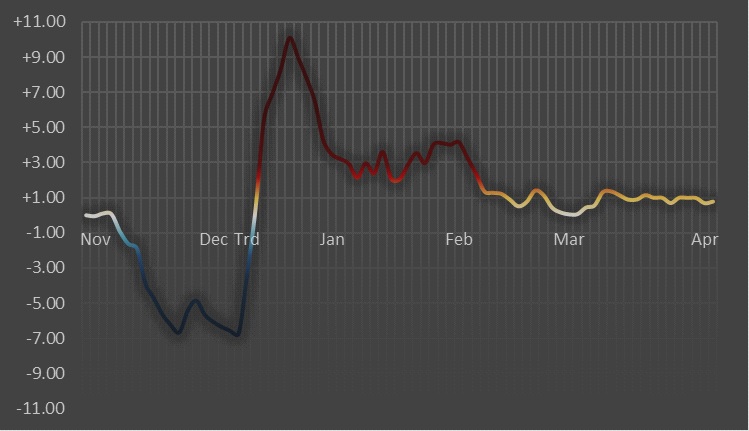
Trades shake both the real and fantasy basketball worlds, and perhaps my graphing system as well, seeing that I had to change the entire RPM scale just to capture the recoil impact of a single trade this season.
Let me clarify: Augustin wasn't traded. Rather, he was waived by the Raptors after they acquired Greivis Vasquez in the Rudy Gay trade. However, for simplicity's sake, I'll credit Augustin's drastic change in RPM to a "trade," as that was practically the case.
Augustin hadn't contributed much as a member of the Raptors, having sat on the bench through a rather unnoticed RPM of -7.00. He started the season off on waivers in most fantasy leagues, and it wasn't until after the trade in December when he finally rose above ground level.
As can be seen, Augustin's RPM skyrocketed to +10.00 almost instantly. When a player reaches this high level of RPM, in most cases that player will be momentarily untouchable.
Consider the seller's perspective: owners who managed to snatch Augustin from the wire knew that his market value was soaring, and they wouldn't want to sell him until they realized exactly what value he could bring back. Even the few extremist owners who have a "sell-high instantly" mindset wouldn't be able to fish for buyers, as it takes more than one, two, or three games to determine a player's stability.
From a buyer's perspective, a trade for Augustin would be undesirable because his RPM of +10.00 would be extremely expensive to purchase. Additionally, a buyer could be skeptical of Augustin initially, because there's always that player who explodes out of nowhere for two games (Aaron Brooks) but never maintains any value moving forward. Thus, at an RPM that high, the owner of the player will likely keep him until his RPM settles into a more sellable value (+1.00 to +3.00). As can be seen in the graph, Augustin's actual value would be perceived two weeks later, and only then did most owners decide whether to sell him or keep him. Over the past two months, his RPM has settled at an average of approximately +1.00, which implies that his market value is more-or-less standard at this point.
Conclusion
Utilizing the various performance meters throughout the fantasy season can be rewarding for owners for both the short run and the long run.
Momentum can help determine which players are worth plucking off the waiver wire before they become a league-wide commodity or which players to consider for daily contests during a given period of time. In addition, relying on a player's momentum can drive a team through the most challenging matchups and the toughest situations.
In every "season within a season," there is always a hot hand to ride and a cold hand to avoid. Learning to capture these trends is a skill and art, not a blind wish or a stroke of luck. Furthermore, observing and gauging relative performance can give owners an understanding of a player's perceived market value, which should point them to taking advantage of opportune buy-low and sell-high trades that are sure to benefit their team at the precise and perfect moment.
By monitoring a player's momentum and relative performance, fantasy managers can learn to master the art of riding the tide, and go from the brink of elimination to a fantasy championship.









